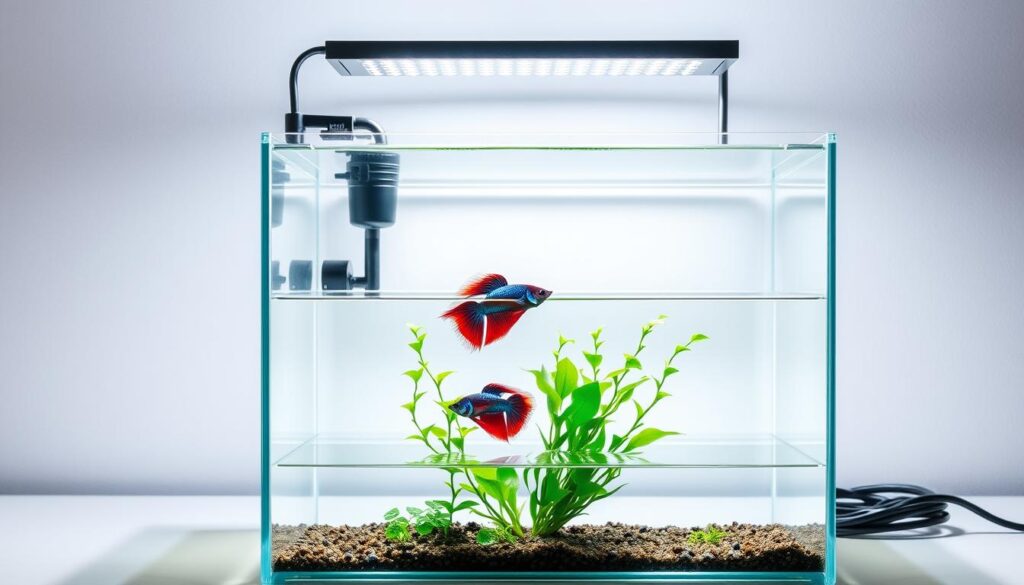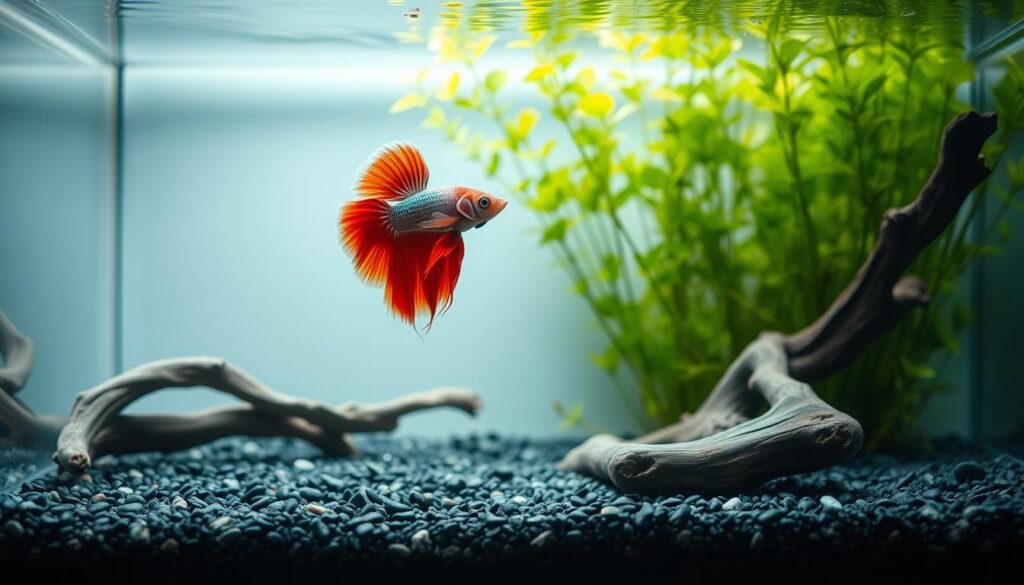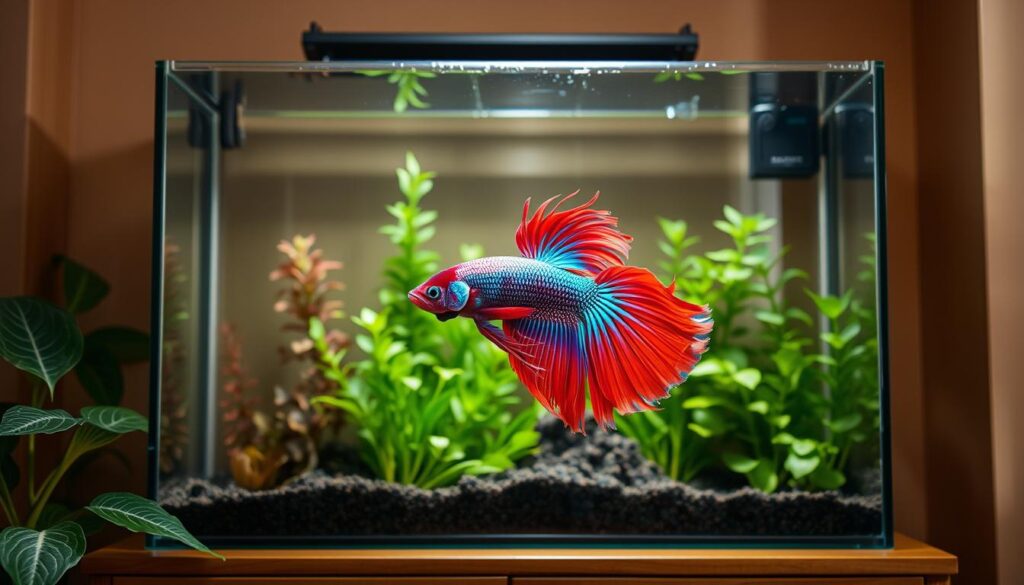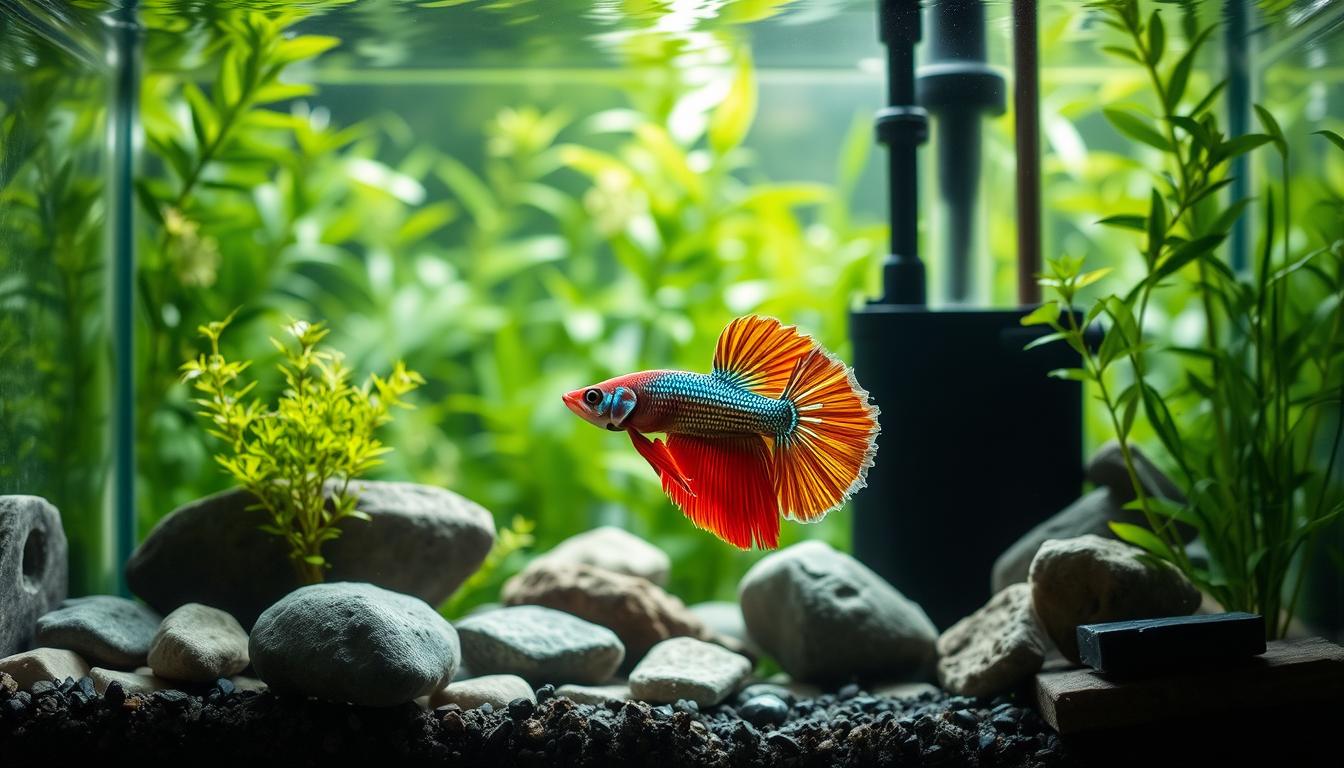As an aquarium enthusiast, I’ve often wondered about the ideal environment for my betta companions. One crucial aspect that stood out was the Betta Fish Minimum Tank Size. It’s essential to understand that betta fish require a suitable tank size to thrive.
Most sources agree that the minimum tank size should be at least 2.5 gallons. This ensures the health and well-being of these beautiful creatures. Providing a suitable environment not only enhances their quality of life but also contributes to their longevity.
Key Takeaways
- The recommended minimum tank size for betta fish is at least 2.5 gallons.
- A suitable tank size is crucial for the health and well-being of betta fish.
- Providing a proper environment enhances the quality of life and longevity of betta companions.
- Betta Fish Minimum Tank Size is a critical factor in their care.
- A larger tank size allows for better water quality and stability.
Why the Betta Fish Minimum Tank Size Matters
Betta fish need a certain tank size to be healthy. This size is not just about space. It’s about creating a good environment for their health and long life.
Common Misconceptions About Betta Fish Habitats
Many think betta fish can live in small containers or bowls. This idea comes from selling them in small cups. But it’s not true.
The “Bettas Live in Puddles” Myth
The myth that betta fish live in puddles is wrong. They come from Thailand’s rice paddies and slow streams. These places have plenty of space for them to swim and live in stable water.
“Betta fish are often misunderstood creatures, and their habitat requirements are frequently underestimated.”
Why Small Bowls Are Harmful
Small bowls are bad for betta fish for several reasons. They don’t have good filtration, leading to bad water. They also don’t have enough room for betta fish to move and exercise, which is key for their health.
- Poor water quality due to inadequate filtration
- Inadequate space for swimming and exercise
- Increased stress levels due to unstable water conditions
The Impact of Tank Size on Betta Health and Longevity
The tank size affects betta fish health and how long they live. A bigger tank means a more stable environment. This is important for betta fish to stay healthy.
| Tank Size | Water Quality Stability | Betta Health Impact |
|---|---|---|
| Less than 2.5 gallons | Unstable, frequent water changes needed | High stress, prone to disease |
| 2.5 gallons or more | More stable, fewer water changes needed | Better health, reduced disease susceptibility |
In conclusion, knowing the right tank size for betta fish is key for their health. By understanding this and debunking myths, betta owners can make a great home for their pets.
The Absolute Betta Fish Minimum Tank Size Requirements
The minimum tank size for betta fish is not just a matter of personal preference; it’s a necessity for their health. Betta fish need enough space to thrive. Understanding this is key to giving them a healthy environment.
Why 2.5 Gallons Should Be Your Starting Point
Experts say a minimum tank size of at least 2.5 gallons is best for betta fish. This size offers enough water to keep conditions stable. This is crucial for their health and well-being. With a 2.5-gallon tank, your betta has the best chance at a healthy life.
Dangers of Keeping Bettas in Containers Under 2.5 Gallons
Keeping betta fish in containers smaller than 2.5 gallons can lead to health issues. Two major problems are temperature fluctuations and ammonia buildup.
Temperature Fluctuation Issues
Small containers are more prone to temperature changes. Betta fish are sensitive to these changes. Frequent changes can stress them, making them more likely to get sick.
Ammonia Buildup Problems
In small tanks, waste products like ammonia can build up fast. Ammonia is toxic to betta fish and can cause serious health problems. Regular water changes are crucial, but small tanks are harder to maintain.
Real Also Are LED Lights for Betta Fish Tanks Harming Your Pet?
To show how tank size affects water quality, look at this table:
| Tank Size (Gallons) | Water Change Frequency | Ammonia Buildup Risk |
|---|---|---|
| 1 | Daily | High |
| 2.5 | Every 2-3 days | Moderate |
| 5 | Weekly | Low |
In conclusion, while betta fish can survive in small containers, their health and longevity improve in larger tanks. As a responsible betta owner, aiming for a tank size of at least 2.5 gallons is a good starting point.
Ideal Tank Sizes for Optimal Betta Fish Health
Betta fish need a tank that fits their size needs for the best life. Knowing the right tank size is key. It helps keep these beautiful fish healthy and happy.
5-Gallon Tanks: The Sweet Spot for Single Bettas
A 5-gallon tank is perfect for one betta fish. It gives them enough room to swim and live well. It also makes keeping the water clean easier.
Having a 5-gallon tank means better water quality. You can also add decorations and plants. These help reduce stress and encourage natural behavior in betta fish.
10+ Gallon Tanks: Benefits for Betta Fish
If you have the space and resources, bigger tanks are even better. Tanks over 10 gallons offer a very stable environment. This means fewer changes in water conditions.
Swimming Space Advantages
Bigger tanks mean more swimming room for betta fish. They love to swim and need space to stay healthy. Too little space can lead to health problems.
Read Also How to Reduce Nitrates in an Aquarium Before They Harm Your Fish
Water Parameter Stability
In larger tanks, water conditions like pH and ammonia levels stay steady. This is important for betta fish. They are very sensitive to changes in their environment.
| Tank Size | Benefits | Considerations |
|---|---|---|
| 5 Gallons | Ample swimming space, easier water quality maintenance | Space constraints for decorations and plants |
| 10+ Gallons | High water parameter stability, more swimming space | Requires more space and resources, higher initial cost |
Essential Equipment for Your Betta Fish Tank Based on Size
To keep your betta fish happy, you need the right equipment for your tank size. The right gear makes your tank look good and keeps your betta healthy.
Filtration Systems Appropriate for Different Tank Sizes
A good filter is key for clean water in your betta’s tank. For tanks 2.5-5 gallons, a soft, adjustable filter is best. It keeps currents gentle, which betta fish like. For tanks over 10 gallons, you can use stronger filters. But make sure they don’t push too much water around your betta.
Key Considerations for Filtration Systems:
- Adjustable flow rates to accommodate betta fish preferences
- Mechanical and biological filtration capabilities
- Regular maintenance requirements
Experts say a good filter does more than clean water. It also creates a stable home for your betta, like their natural habitat.
“The right filtration system can make all the difference in the health and happiness of your betta fish,”
an expert aquarist notes.
Heating Requirements Based on Tank Dimensions
Betta fish love warm water. The size of your tank and the room’s temperature affect how much heat it needs. For small tanks, a tiny heater that fits in the water is best. In bigger tanks, you might need a stronger heater or two to keep the water warm everywhere.
Important Factors for Heating:
- Choosing a heater with the appropriate wattage for your tank size
- Ensuring even heat distribution
- Monitoring temperature with a reliable thermometer

Keeping the water at the right temperature is very important. Betta fish don’t like it when the temperature changes too much. Aim for a steady 76-82°F (24-28°C) for your betta’s comfort.
Setting Up the Perfect Betta Tank Environment Within Size Constraints
To keep your betta fish happy, you need to create the right tank environment. This means picking the right substrate, plants, and decorations. These choices should make your tank look good and keep your betta healthy and happy.
Substrate Options for Different Tank Sizes
Choosing the right substrate is key. It affects your tank’s ecosystem and your betta’s comfort. For small tanks, pick something easy to clean. In bigger tanks, you can try different substrates to create a natural look.
Nutrients and Stability: Some substrates help plants grow by releasing nutrients. But, they need more care to keep the tank stable.
Plants and Decorations: Space Considerations
Plants and decorations do more than look good. They give your betta places to hide and reduce stress. It’s important to find a balance between decoration and space for swimming.
Live Plants vs. Artificial in Small Tanks
Live plants are great, but they need special light and care. In small tanks, artificial plants might be easier. They offer the same benefits without the extra work. But, some people successfully keep live plants in small tanks with the right care.
“Live plants can enhance the environment, but they demand a commitment to their care.”
Creating Hiding Spots Without Overcrowding
To keep your betta calm, add decorations that offer hiding spots. Use a mix of tall plants or decorations in the back and leave space for swimming. This balance is key for your betta’s well-being.
- Choose decorations that are safe for your betta to avoid fin damage.
- Arrange decorations to create pathways and hiding spots.
- Leave enough open space for your betta to swim freely.
How Betta Fish Minimum Tank Size Affects Water Quality
The size of a betta fish tank really matters for water quality. A bigger tank means a more stable home for your fish. This is key for their health.
The Nitrogen Cycle in Different Sized Tanks
The nitrogen cycle is super important in aquariums. It turns fish waste into nitrate. But, in small tanks, this cycle can be shaky.
This leads to spikes in harmful ammonia and nitrite levels. These can hurt your betta fish.
In bigger tanks, the cycle is steadier. The extra water helps dilute waste. This gives beneficial bacteria more time to work. This is crucial for keeping water healthy.

Water Change Frequency Based on Tank Volume
Changing the water regularly is key for quality. How often you do this depends on the tank size. Smaller tanks need more frequent changes because they fill up with waste faster.
| Tank Size (Gallons) | Recommended Water Change Frequency |
|---|---|
| 2.5 | Every 3-4 days |
| 5 | Every 7-10 days |
| 10+ | Every 10-14 days |
Knowing how tank size affects water quality helps. Adjusting your care routine can make a big difference. This way, you can give your betta fish a healthier home.
Tank Size Requirements for Betta Fish with Tank Mates
When you think about adding tank mates to your betta fish’s home, knowing the tank size is key. Betta fish can live with others, but picking the right tank mates is crucial. Make sure your tank is big enough.
Compatible Tank Mates Based on Tank Size
The tank size affects which fish can live with your betta. For small tanks (about 10 gallons), pick peaceful, small fish. They won’t bother your betta. Good choices include neon tetras, harlequin rasboras, and corydoras catfish.
For tanks of 10 gallons or less, here are some good tank mates:
- Neon tetras
- Harlequin rasboras
- Corydoras catfish
- Shrimps (such as Amano or ghost shrimps)
For larger tanks (20 gallons or more), you can add more tank mates. Consider:
- Dwarf cichlids
- Other peaceful community fish
- Additional shrimp species
| Tank Size (Gallons) | Compatible Tank Mates |
|---|---|
| 5-10 | Neon tetras, harlequin rasboras, corydoras catfish, shrimps |
| 10-20 | Add dwarf gouramis, other small peaceful fish |
| 20+ | Dwarf cichlids, additional peaceful community fish, more shrimp species |
Space Requirements for Community Tanks with Bettas
The space needed for community tanks with betta fish varies. It depends on the tank size, fish number, and decorations. A good rule is to have 1-2 inches of fish length per gallon, not counting the betta.
For example, a 10-gallon tank is a minimum for a betta and 2-3 small fish (each about 1 inch long).
Following betta fish tank size recommendations and choosing the right tank mates will help your community tank thrive.
Signs Your Betta Needs a Larger Tank Than Minimum Size
Knowing when your betta fish needs a bigger tank is key to its health and happiness. The minimum tank size is a good start, but sometimes your betta needs more room. This is crucial for the best care.
Behavioral Indicators of Insufficient Space
Betta fish show certain signs when their tank is too small. Watching these signs can tell you if your betta needs more space.
Lethargy and Reduced Activity
If your betta seems tired or less active, it might be too small for its tank. Healthy betta fish love to swim. If they’re not swimming much, they might need more room to play.
Aggressive Behaviors
Aggressive acts, like fin nipping or attacking decorations, mean your betta’s tank is too small. Bettas need space to claim their territory without feeling trapped.

Health Issues Related to Inadequate Tank Size
Health problems can also show that your betta needs a bigger tank. Small tanks often lead to bad water quality. This can cause diseases and parasites.
Keep an eye on your betta’s health and tank conditions. If you see signs of illness or stress, a bigger tank can help. It will make a healthier home for your betta.
Budget-Friendly Options That Meet Betta Fish Minimum Tank Size Standards
There are many affordable ways to meet the tank size needs for betta fish. You don’t have to spend a lot to give your betta a great home. Here are some budget-friendly ideas to consider.
Affordable Tank Kits That Meet Size Requirements
Starting with a betta tank kit can save money. These kits usually have everything you need, like a tank, filter, and heater. Here are some important things to look for:
- Tank Size: Make sure the kit includes a tank that’s at least 2.5 gallons.
- Filtration: A good filter is key for clean water. Choose kits with adjustable or low-flow filters.
- Heating: Bettas need warm water. Some kits come with a heater.
Popular affordable tank kits come from Tetra and API. They usually have everything you need for a betta-friendly tank.
DIY Solutions for Proper Betta Housing
If you’re handy or on a tight budget, DIY can be a great option. Here are some ideas:
- Upcycle Old Containers: Clean and set up old containers to make betta tanks.
- Customize Your Tank: Add plants, decorations, and substrate to make your betta’s home better without spending a lot.
By exploring these budget-friendly options, you can give your betta a healthy and happy home. This way, you can follow betta aquarium size guidelines without spending too much.
Conclusion
Knowing the betta fish minimum tank size is key to keeping your pet healthy. A small tank can cause health problems and shorten their life.
Choosing a tank that meets the size needs ensures your betta fish thrives. With the right equipment and care, you’ll create a happy home for them.
It’s important to put your betta fish’s health first. Picking the right tank size is a big step. Think about what your pet needs and make smart choices for their care.
By doing this, you’ll get to see your betta fish grow and enjoy their unique beauty. It’s a rewarding experience that brings joy to your life.

